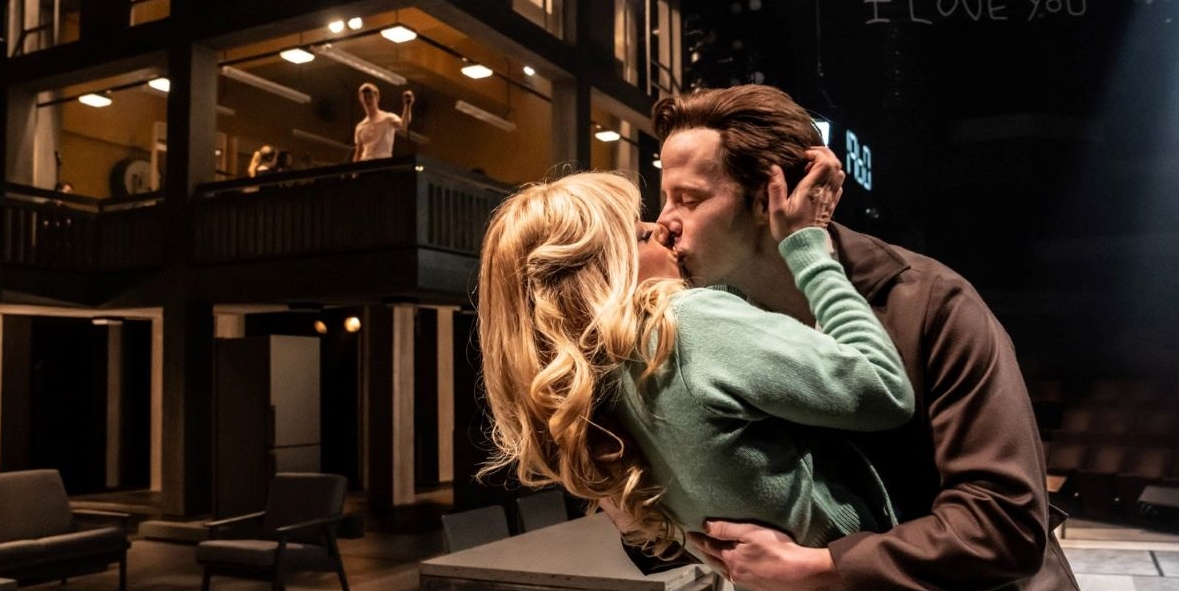I Love You Will U Marry Me?
These words stand resolute above the stage, and immediately display the childish hopefulness for belonging, pervasive within this production. Parallel interlinked stories often imply a neglect of character development and the audiences stake in the narrative. With regards to Standing at the Sky’s edge, this could not be further from the truth. Chris Bush’s show adds to her impressive oeuvre of musicals combining topical and partly comedic ideas. The direction of Robert Hastie and choreography of Lynne Page come together to create powerful scenes and moments, which create an extremely successful transmission of the source material. The play features a potent ensemble and is set across three distinct periods, beginning in the sixties, eighties and near the present day, with each period experiencing time jumps for narrative development. Despite, or perhaps due to its lengthy but not laborious two hours and fifty-minute runtime, the play expertly crafts and melds the proximate but seemingly disconnected storylines and forges a truly atmospheric and exhilarating performance.
The pace of the play is skilfully fashioned and brings us from the edge of emotional subtlety, to sheer climaxes of dramatic outpourings of song. There are moments of tenderness and moments such as that which close the first act, which strike awe and wonder into the audience, with the entire cast joined in song and a singular focus. The plays ability to juxtapose, heightened by moments of cross cutting, choral singing and the sharing of objects and space, allows for the feeling of efficient storytelling, whilst maintaining and heightening the ability to convey the message of the play. A key scene in which all three time periods experience Henderson’s Relish, perfectly aligns the distinct characters. A recurring theme, throughout, is the idea of gentrification, which is portrayed as a nuanced issue, but one which is not as simple as characters both within and outside the play have suggested.
The musical is ultimately about the ideas of home and belonging, especially amidst crises, whether that be the decline of the industrial north in the 70’s and 80’s in Britain, unrest in Liberia or a midlife and relationship crisis. Each grouping is presented as being a symptom of its eras and representative of something empathetic. These crises experienced by the characters are not compared by order of magnitude, minimised or weakened, but rather shown as merely different, valid, lived experiences, which all occur in the same place, years apart.
The songs of Richard Hawley used throughout the play are magnificent and sung with passion and both delicate and manifest emotion. They are in the style of contemporary ballad or perhaps English northern soul. In particular Open Up Your Door and Naked in Pitsmoor deliver stunning vocal experiences with heart-wrenching renditions delivered by Maimuna Memon and Alex Young respectively. In contrast Baker Mukasa offers a joyful execution of Tonight the Streets are Ours, which will be stuck in your head in the best ways.
The only criticism of the music would be that, because the songs are pre-existing they do not always link to the material, but rather act as an emotional crutch without advancing the plot. Notwithstanding this, the acting throughout the musical is equally strong, despite this the performances of Faith Omole and Alex Young remain paramount in their nimble execution of comedic timing, tonality and intricate facial and body expressions. They along with the rest of the cast, play no part in diminishing the magic of the stage and script, and if anything, heighten it. These intertwined stories manage to portray a unity of purpose and celebration of human connection, even despite the different values, culture, and experiences of its characters.

